One of the biggest mistakes video service businesses make when managing their viewers is to incorrectly segment their audience or to treat all subscribers the same way. The right approach lies in highly detailed, fine-tuned audience segmentation. Why? Because greater customer segmentation will be reflected in increased customer loyalty.
Be smart about how you drill down on your audience
Fundamentally, you have to know your audience. It no longer suffices to separate your viewers into “potential,” “current,” or “lost” customer categories. The new industry reality demands that you delve down to an individual customer level. This is what will add value to your video business and create steadfast customers. To achieve this, you will need to use specific criteria to segment your audience.
Here’s a simple example to illustrate why we shouldn’t target the entire customer base the same way: Imagine a company makes pet food. Now imagine that this company launches a new line of dog food. During its marketing campaign it doesn’t refine its segmentation. By targeting customers who have bought pet food, the company has also included cat-owners in its campaign. Why invest the effort and money for half an audience that has zero interest? While it might seem obvious, the same applies to how you manage the viewers of your video service. It is not uncommon to receive newsletters about a video service’s content that recommends certain movies or series to an entire customer base. Oftentimes the customer has already seen the recommended content or is simply not interested in it.
This will influence business results, and it’s likely they won’t be as hoped. If we want our audience engagement to result in more loyal customers, viewer segmentation has to be more accurate and relevant across all the touchpoints of our video service.
What types of segmentation can we use?
There are many ways we can apply segments. There is no one-size-fits-all approach, but some relevant examples from the most generic to more specific could be: by geography; customer type (new, existing, subscribers, returning subscribers, transactional, etc.); behavior (engagement level, type of content consumed, most watched genres); and even interests or communities (Real Madrid fans, manga-lovers, sci-fi freaks, etc.).
Let’s look in more detail at some of the segment types that you can use in your video service.
Demographic segmentation
This type of segmentation filters our audience by gender, age, economic status, marital status, level of education, etc. This type of segmentation doesn’t go very deep, but if we cross-reference it with the most relevant KPIs for our business, it can give us insight into key characteristics of our viewer base.
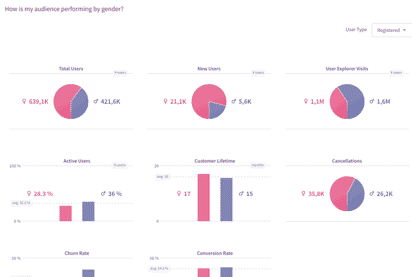
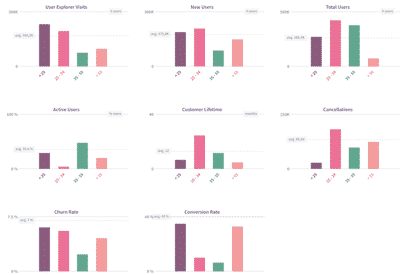
With this information we can more accurately target our video service acquisition, engagement, retention, and personalization activities.
By way of example, in the chart above we see that the 25 and younger age segment has the highest conversion rate of trial users to paying customers, but at the same time it is also the segment with the most churn, thus resulting in low customer lifetime value. This can give us insight into how to design and implement different engagement and retention strategies for this viewer segment, a segment comprised of viewers who demonstrate interest in our product, but don’t stay with us very long.
We cannot rely exclusively on this type of segmentation. We need to take it a step further, specifying as much detail as possible. For example: where is our audience?
Segmentation by audience location
Where do our viewers with the best conversion rate come from? Or those with the greatest customer lifetime value? Or the highest number of cancellations? These are just some of the questions we can answer by using segmentation based on geography, and the answers will have a direct impact on the activities we plan for our video service.
In the example shown below, we see that users in Wisconsin have the highest conversion rate. Based on this data, when investing in marketing activities, we can segment our customer acquisition campaigns to target our Wisconsin users, thus reducing customer acquisition costs.
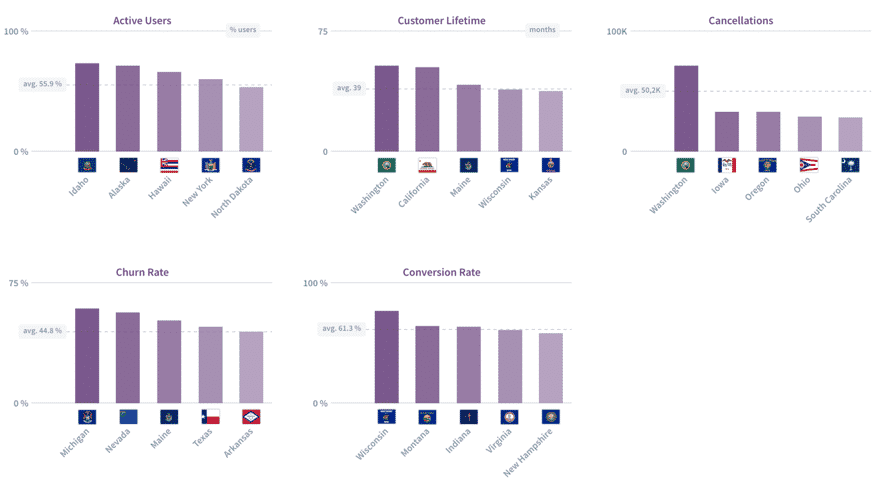
Another example based on the analysis above would be to prioritize users in Washington for our retention activity, given that this is the group with the most cancellations and by focusing on them, we will optimize the positive impact on our video service churn rate.
We can also analyze where our video content is being played. With this approach, we can determine the location of our viewers and enhance our service by offering more specific location-based content. For example, lists displaying most-watched content can be personalized to target a specific region. Within this segmentation type we can segment even further, using audience microsegmentation to extract even more location data, like their state, city, or even neighborhood.
Segmentation by viewer behavior
Segmenting by behavior tells us a lot about what our audience wants from us. We can gain a much better understanding of our viewers from their patterns of behavior: how viewers behave throughout the whole process, prior to playing content, while watching content, and what they do once the content has finished. This understanding can guide our activity. For example, once we’ve identified a frequent viewer of comedy series, while s/he’s watching something from this genre, we can recommend other comedy series we think will be of interest.
Below are some relevant examples of behavior-based viewer segmentation.
Segmentation by level of engagement:
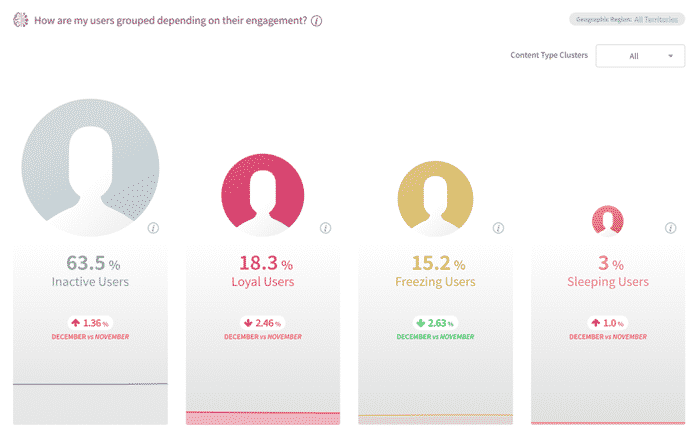
Segmentation by type of content watched:
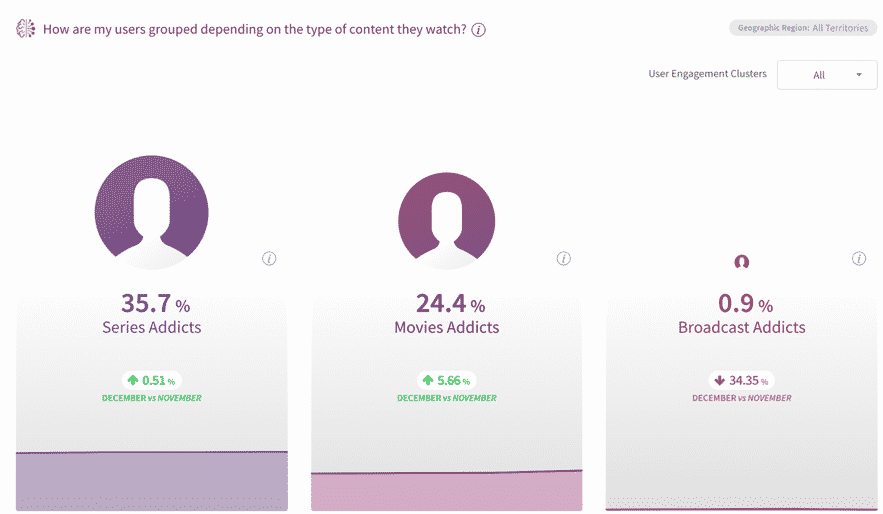
Segmentation by genre watched:
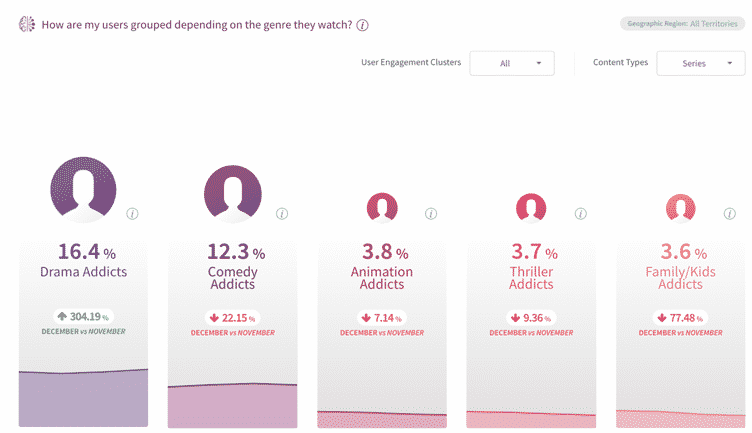
Segmentation based on viewer interests and lifestyle
This segmentation is determined by psychological criteria, such things like the attitude and aptitude of our viewers. This is where audience lifestyle, aspirations, and interests come into play. What are our viewers passionate about? Who do they look up to? What kind of food do they like? Do they prefer the beach or the mountains?
Netflix popularized this type of segmentation with their “taste communities.” Netflix scientists found that there are several connections among content types and what people like to watch, which goes several layers deeper than genres. They refer to these as “taste communities” and have identified 2,000 that describe exactly what all of us like to watch.
This approach should not be the exclusive domain of Netflix. Other video services in the industry are perfectly capable of creating user communities based on different behavioral criteria. Below we see an example of a community of fans for a team in the U.S. Soccer league.
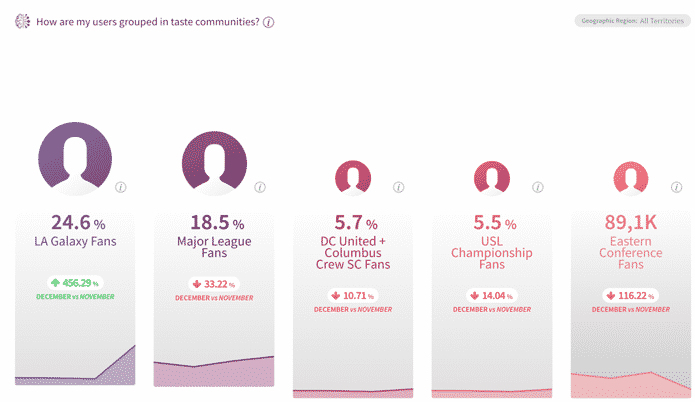
Advantages of audience segmentation
Any kind of strategic marketing activity that we undertake without knowing our customer base or using appropriate segmentation will undoubtedly lead us to fail in our attempt to hit our defined targets.
So, what are the benefits we get from audience segmentation?
An overall improvement of our video business
Without question, the better we get to know our viewers, the more we will know about what they want from an entertainment service and what it needs. Only with this knowledge can we give them what they want, improving our product offering with their opinions as input. A user experience that provides value and makes customers feel like you care about them will be the defining factor in the customer’s choice of a video platform. Will it be yours or the competition’s?
Increase conversion. Reduce waste.
Having taken an audience-centric approach, it is more likely that our viewers will become repeat customers and will recommend us to others. Investing in the right segment is a much better use of our marketing budget than pouring resource into a segment that probably isn’t interested in our service.
